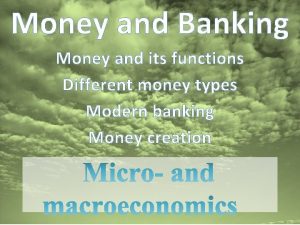Money and its functions functions of money medium





- Slides: 5

Money and its functions - functions of money: medium of exchange (means of payment) & value unit, asset (wealth accumulation) - medium of exchange: solution to avoid barter in multigood exchange (separation of buying from selling); value unit: need of standardization to ensure price transparency (basis for becoming medium of exchange) - wealth accumulation: saving instead of spending, tradeoff with medium-of-exchange function - occurence of coinage (standardization and certification of means of exchange) at relatively late stage of human history (7 th century BC, Lydia), instead of use of generally accepted commodities (metals as early as 2000 BC) or tokens; counting easier than weighing 1

Early history of money - wide use of metal money in ancient Greece and Rome (denaturalization of economy), problems resulting from lowering the precious metal content in coins (fiscal purposes of authorities, counterfeiting coins by the public, in the long run also due to natural wearing off) – Gresham’s Law in action - monetary crises resulting from often debasements and lack of precious metals – beginnings with the reign of Nero (54 -68 AD) - demonetization of economy in early Middle Ages - remonetization after 1000 AD (together with development of commerce and cities) - lack of stable currencies for most of the Middle Ages - Italian cities (Florence, Venice, Genoa) as places of origin of the most popular coins - increasing role of Central Europe as source of precious metals in late Middle Ages (Bohemian silver – grossus, thaler, Hungarian gold) - domination of silver in coinage (gold used for wealth accumulation) 2

Early modern history of money - - inflow of Southern American silver - 2 nd half of 16 th century, rising price of gold (change of price ratio to silver from 1: 10 to ca. 1: 15) paradox of declining economic position of Spain combined with main role as a supplier of specie for Europe sir Thomas Gresham, 1558, ”bad money drives out the good” Crisis of 17 th century – monetary explanations monetary debasements and crises – central bank as solution (1668 - Sweden, 1694 - England), beginnings of paper money (fiduciary emission of central bank notes, mechanism known from earlier activity of goldsmith banks) Sir Isaac Newton & gold-silver parity of the pound at 1: 16 (overvalued gold drives out silver), 1717 French failure (John Law system 1716 -1720 – central bank with capital on jointstock basis issuing redeemable paper money of fixed value + tax collection + coinage + joint-stock Mississippi Company promising profits from colonial trade & uninitiated exploitation of Louisiana – after initial success of restoring state budget solvency collapse due to lack of real basis for repaying bank notes & state-issued securities), hence French distrust of banks English speculation on joint-stock companies (South Sea Bubble, 1720) parallel to John Law, hence English distrust of limited liability expressed in Bubble Acts French revolution and paper money inflation (fiat money based on the government’s word) – later inability to redeem in specie without discounts; hence bad opinion of paper money 3

Quantity theory of money - Inflation (rising price level) is in close positive relation with changes in money supply - Developed by empirist philosophers of Enlightenment (David Hume) - Anti-mercantilist implications: if accumulation of money is raising prices, so positive trade balance (goal of mercantilist policy) would increase inflation but would not increase wealth - Part of liberal, free-trade economic program in 19 th century - Failure to formulate adequate policy response to Great Depression - Refreshed by Milton Friedman and monetarists in 1960’s and later decades (monetary roots of economic cycles) - Problems with policy applications due to imprecision of the term ”money supply” since early 1980’s 4

Money in long 19 th century - - - Britain adopting monometallic Gold Standard in 1821 (after 1797 -1815 suspension of conversion of notes into gold and return to redeemable currency in 1816) continental experiences with bimetallism (in the 1 st half of the century de facto silver standard), Latin Monetary Union (France, Italy, Belgium, Switzerland) created in 1865 monetary explanations of Kondratieff cycles (1850’s expansion - California and Australia, 1890’s - Alaska and South Africa combined with technology shock) after 1850 gold money drives out silver, Gold Standard adoption by most of European countries: Germany 1871 -1873, LMU 1873 -1878 (silver coins based at franc parity remained in circulation, although being gradually withdrawn), Scandinavian Union (Denmark, Sweden & Norway 1872 -1875), the Netherlands 1875 universal character of Gold Standard during 1 st Globalization (except China & Far East), gold points, inability of governments to conduct expansive policies American experience (lack of central bank after 1811, 1792 (1: 15) and 1834 (1: 16) dollar parities (as effect silver standard between these dates), greenbacks and Civil War – dollar convertible into specie as late as in 1879, silver party – coalition of silver-producing states overrepresented in Senate, 1913 – Federal Reserve System [Fed]) World War I – end of classic Gold Standard 5








